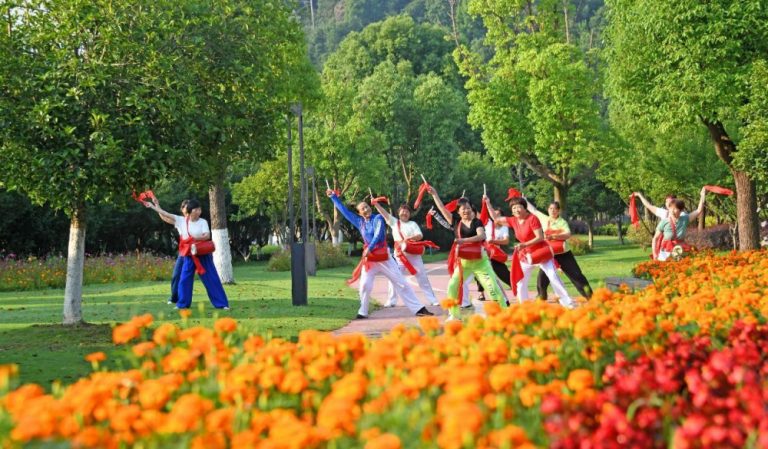
By Ye Xiaonan, Wang Shengying
Over recent years, parks across China have innovatively upgraded themselves, improving the quality of green space and introducing more facilities, which lifts both urban appearance and people’s living quality.
According to statistics, from 2012 to 2021, green coverage of China’s built-up urban areas improved from 39.22 percent to 42.06 percent, and the per capita area of park greenery increased from 11.8 square meters to 14.78 square meters.
The Changqing Park in Wuhan, central China’s Hubei province, employs a 5G intelligent management system that monitors air quality, water quality, and soil moisture in real-time and then utilizes the data for park maintenance. It is the first park in Wuhan to employ such a system.
Besides, the park implements water purification, microclimate control, and biodiversity maintenance measures to conserve its wetland through digital and intelligent means to present vital and beautiful landscapes.
A sports center built in the Chuangxin Park in Guangzhou, south China’s Guangdong province, has become a hot destination for nearby residents to relax.
“We always visited the park to watch the flowers. After upgrading the park, we can also do fitness activities while enjoying the beautiful view. My child loves the basketball courts in the park very much,” said a citizen surnamed Li.
To meet the fitness demands of nearby people, the sports center has newly built a 1,200-square-meter sports area and a soccer pitch that covers about 5,000 square meters. It also offers a variety of fitness equipment and recreational facilities.
A fitness trail is attracting many children in a park in Fuqing, southeast China’s Fujian province. When devices along the route sense movement, various moving images are projected on the trail with lights and music, creating an exciting and magical interactive scene for children visiting the park, especially at night.
Parks nationwide have utilized idle space during upgrading to meet citizens’ demands and enrich their experiences.
For instance, Qixia township, southwest China’s Chongqing municipality, has established pocket parks and mini-parks on unoccupied leftover land. Small as they are, these parks have green belts and benches, sports fields, cultural activities squares, kid’s playgrounds, and fitness areas. They are an excellent destination for fitness and leisure for surrounding residents.
“It used to be a waste ground, but now a clean and comfortable square has been built with basketball courts and fitness areas. We dance in the park daily,” said resident Xiao Benfang, thumbing up to a nearby park.
Introducing the cultural and historical elements is also essential for park upgrading.
In April this year, a park at the source of the Grand Canal, a vast waterway connecting the northern and southern parts of China, officially opened to the public in Beijing’s Changping district after renovation. It carries the Baifu Spring’s cultural characteristics, a water source of historical significance for China’s Yuan Dynasty (1271-1368) and Ming Dynasty (1368-1644).
So far, the park has received a total of over 160,000 visits.
“The environment in this park is fantastic after renovation. It makes the site of the Baifu Spring known to more people,” said citizen Cui Yuanwei. She often takes a walk in the park to enjoy the beautiful view and experience the traditional culture of Beijing.
“Changping district will launch study tours, free lectures, and other activities on water conservancy popularization. It will also host book clubs, forums, and salons to spread the culture of the Grand Canal better,” said an official with the district.
The Dong’an Park in Shanghai, adjacent to the Wanping Theater, a historical facility built in 1988, has well integrated itself with opera culture. It has a “natural stage” consisting of two Chinese-style bamboo pavilions on the bank of the park’s lake and a waterside trail connecting them, while the open space on the bank of the lake serves as a great spectators stand.
Insiders noted that upgrading public space strengthens the cultural vitality of cities and shapes new lifestyles of citizens and tourists. In the future, parks will have more public cultural spaces to lift the urban image and record the urban culture.










